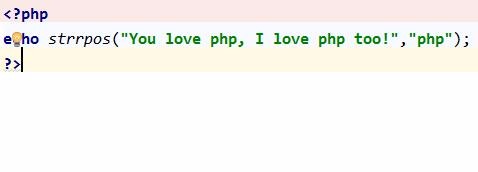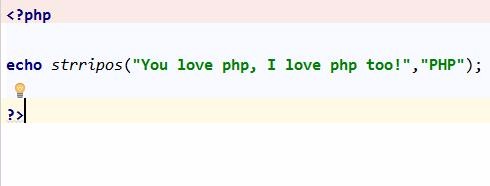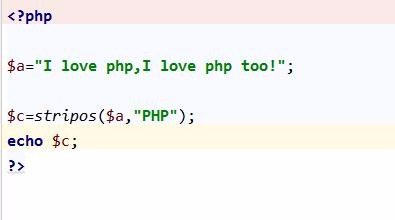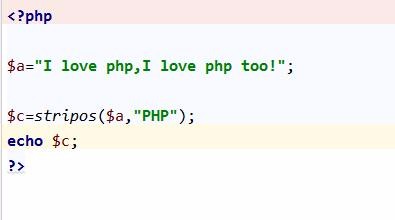10 recommended articles about pos()
php What is the role of string function stripos()? The string function stripos() is to find the first occurrence of a string in another string. This function is not case-sensitive. It is very convenient to use, and its related functions are strripos() - Find the last occurrence of a string in another string (case-insensitive) strpos() - Find the last occurrence of a string in another string The position of one occurrence (case-sensitive) strrpos() - Find the position of the last occurrence of a string in another string (case-sensitive) Let's take a look at the syntax of the stripos() function stripos(string,find,start ) This function has three parameters, the first two parameters are required, and the third parameter is optional and the parameter description string is required. Specifies the string to be searched for. find required. Specifies the characters to search for. start is optional. Specifies the location from which to start the search. The return value of the stripos() function. The stripos() function returns a string in another string.
1. 10 recommended content of pos()

Introduction: What is the role of php string function stripos()? The string function stripos() is to find the first occurrence of a string in another string. This function is not case-sensitive. It is very convenient to use, and its related functions are strripos() - Find the last occurrence of a string in another string (case-insensitive) strpos() - Find the last occurrence of a string in another string The position of the first occurrence in the string (case sensitive) strrpos() - Find the string in...
2. Recommended articles about stripos 10 Article

Introduction: What is the role of the PHP string function stripos()? The string function stripos() is to find the first occurrence of a string in another string. This function is not case-sensitive. It is very convenient to use, and its related functions are strripos() - Find the last occurrence of a string in another string (case-insensitive) strpos() - Find the last occurrence of a string in another string The position of the first occurrence in the string (case sensitive) strrpos() - Find the string in...
3. About the php stripos() function Recommended 10 articles

## Introduction: What is the role of the PHP string function stripos()? The string function stripos() is to find the first occurrence of a string in another string. This function is not case-sensitive. It is very convenient to use, and its related functions are strripos() - Find the last occurrence of a string in another string (case-insensitive) strpos() - Find the last occurrence of a string in another string The position of the first occurrence in the string (case sensitive) strrpos() - Find the string in...
4. About the php pos() function Recommended 10 articles

5.
Detailed introduction to php string functions

Introduction: What is the role of PHP string function stripos()? The string function stripos() is to find the first occurrence of a string in another string. This function is not case-sensitive. It is very convenient to use, and its related functions are strripos() - Find the last occurrence of a string in another string (case-insensitive) strpos() - Find the last occurrence of a string in another string The position of the first occurrence in the string (case sensitive) strrpos() - Find the string in...
6. Detailed explanation of the string function strrpos( )

Introduction: strrpos() function finds the last occurrence of a string in another string Location. This function is case-sensitive, contrary to the strripos() function, which is not case-sensitive. This article will guide you to understand the php strrpos() function.
7. php string function strripos() example detailed explanation

Introduction: The php strripos() function is to find the last occurrence of a string in another string. This function is not case sensitive,
8. php strpos() function example detailed explanation

Introduction: The strpos() function finds the first occurrence of a string in another string. It should be noted that this function is case-sensitive, contrary to the php stripos() function, which is not case-sensitive. This article will take you through the php strpos() function.
9. Definition and usage of php string function stripos()

Introduction: The string function stripos() is to find the first occurrence of a string in another string. This function is not case-sensitive. It is very convenient to use
10. php function method knowledge
Introduction::php function method knowledge: 1. The strlen() function returns the length of the string in characters. strlen returns the length of the string. strlen("hello") displays 52. The strpos() function is used to retrieve the specified characters or text within the string. strpos("hello","e") displays 1 because it starts counting from 0. 3. Valid constant names start with a character or an underscore (there is no $ sign in front of the constant name). Note: Unlike variables, constants are automatically global throughout the script. 4. The count() function is used to return the length of the array (element
The above is the detailed content of 10 recommended articles about pos(). For more information, please follow other related articles on the PHP Chinese website!

Hot AI Tools

Undresser.AI Undress
AI-powered app for creating realistic nude photos

AI Clothes Remover
Online AI tool for removing clothes from photos.

Undress AI Tool
Undress images for free

Clothoff.io
AI clothes remover

Video Face Swap
Swap faces in any video effortlessly with our completely free AI face swap tool!

Hot Article

Hot Tools

Notepad++7.3.1
Easy-to-use and free code editor

SublimeText3 Chinese version
Chinese version, very easy to use

Zend Studio 13.0.1
Powerful PHP integrated development environment

Dreamweaver CS6
Visual web development tools

SublimeText3 Mac version
God-level code editing software (SublimeText3)

Hot Topics
 1662
1662
 14
14
 1419
1419
 52
52
 1311
1311
 25
25
 1262
1262
 29
29
 1235
1235
 24
24
 Explain different error types in PHP (Notice, Warning, Fatal Error, Parse Error).
Apr 08, 2025 am 12:03 AM
Explain different error types in PHP (Notice, Warning, Fatal Error, Parse Error).
Apr 08, 2025 am 12:03 AM
There are four main error types in PHP: 1.Notice: the slightest, will not interrupt the program, such as accessing undefined variables; 2. Warning: serious than Notice, will not terminate the program, such as containing no files; 3. FatalError: the most serious, will terminate the program, such as calling no function; 4. ParseError: syntax error, will prevent the program from being executed, such as forgetting to add the end tag.
 PHP and Python: Comparing Two Popular Programming Languages
Apr 14, 2025 am 12:13 AM
PHP and Python: Comparing Two Popular Programming Languages
Apr 14, 2025 am 12:13 AM
PHP and Python each have their own advantages, and choose according to project requirements. 1.PHP is suitable for web development, especially for rapid development and maintenance of websites. 2. Python is suitable for data science, machine learning and artificial intelligence, with concise syntax and suitable for beginners.
 Explain secure password hashing in PHP (e.g., password_hash, password_verify). Why not use MD5 or SHA1?
Apr 17, 2025 am 12:06 AM
Explain secure password hashing in PHP (e.g., password_hash, password_verify). Why not use MD5 or SHA1?
Apr 17, 2025 am 12:06 AM
In PHP, password_hash and password_verify functions should be used to implement secure password hashing, and MD5 or SHA1 should not be used. 1) password_hash generates a hash containing salt values to enhance security. 2) Password_verify verify password and ensure security by comparing hash values. 3) MD5 and SHA1 are vulnerable and lack salt values, and are not suitable for modern password security.
 PHP in Action: Real-World Examples and Applications
Apr 14, 2025 am 12:19 AM
PHP in Action: Real-World Examples and Applications
Apr 14, 2025 am 12:19 AM
PHP is widely used in e-commerce, content management systems and API development. 1) E-commerce: used for shopping cart function and payment processing. 2) Content management system: used for dynamic content generation and user management. 3) API development: used for RESTful API development and API security. Through performance optimization and best practices, the efficiency and maintainability of PHP applications are improved.
 What are HTTP request methods (GET, POST, PUT, DELETE, etc.) and when should each be used?
Apr 09, 2025 am 12:09 AM
What are HTTP request methods (GET, POST, PUT, DELETE, etc.) and when should each be used?
Apr 09, 2025 am 12:09 AM
HTTP request methods include GET, POST, PUT and DELETE, which are used to obtain, submit, update and delete resources respectively. 1. The GET method is used to obtain resources and is suitable for read operations. 2. The POST method is used to submit data and is often used to create new resources. 3. The PUT method is used to update resources and is suitable for complete updates. 4. The DELETE method is used to delete resources and is suitable for deletion operations.
 PHP: A Key Language for Web Development
Apr 13, 2025 am 12:08 AM
PHP: A Key Language for Web Development
Apr 13, 2025 am 12:08 AM
PHP is a scripting language widely used on the server side, especially suitable for web development. 1.PHP can embed HTML, process HTTP requests and responses, and supports a variety of databases. 2.PHP is used to generate dynamic web content, process form data, access databases, etc., with strong community support and open source resources. 3. PHP is an interpreted language, and the execution process includes lexical analysis, grammatical analysis, compilation and execution. 4.PHP can be combined with MySQL for advanced applications such as user registration systems. 5. When debugging PHP, you can use functions such as error_reporting() and var_dump(). 6. Optimize PHP code to use caching mechanisms, optimize database queries and use built-in functions. 7
 How does PHP handle file uploads securely?
Apr 10, 2025 am 09:37 AM
How does PHP handle file uploads securely?
Apr 10, 2025 am 09:37 AM
PHP handles file uploads through the $\_FILES variable. The methods to ensure security include: 1. Check upload errors, 2. Verify file type and size, 3. Prevent file overwriting, 4. Move files to a permanent storage location.
 Explain the difference between self::, parent::, and static:: in PHP OOP.
Apr 09, 2025 am 12:04 AM
Explain the difference between self::, parent::, and static:: in PHP OOP.
Apr 09, 2025 am 12:04 AM
In PHPOOP, self:: refers to the current class, parent:: refers to the parent class, static:: is used for late static binding. 1.self:: is used for static method and constant calls, but does not support late static binding. 2.parent:: is used for subclasses to call parent class methods, and private methods cannot be accessed. 3.static:: supports late static binding, suitable for inheritance and polymorphism, but may affect the readability of the code.




